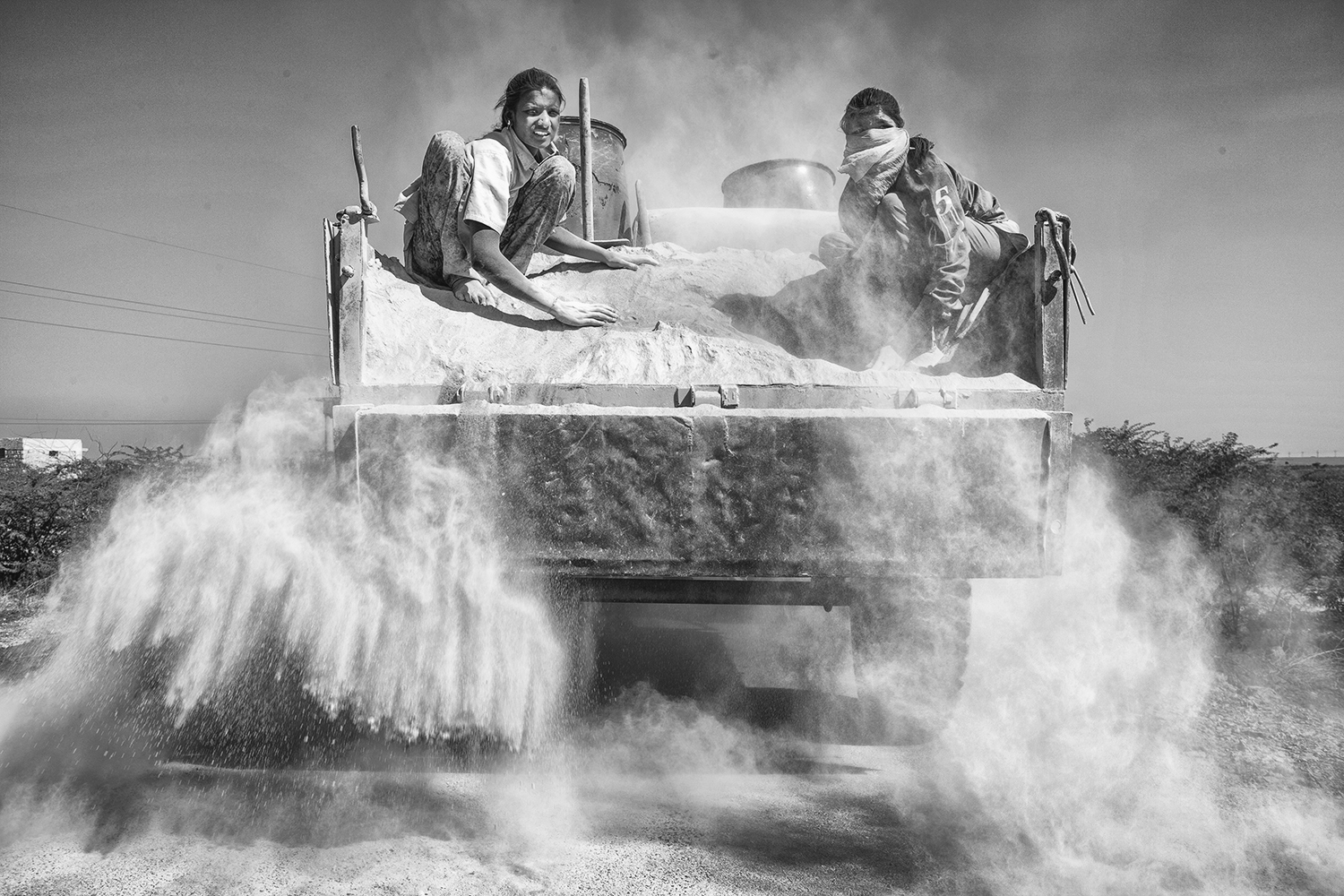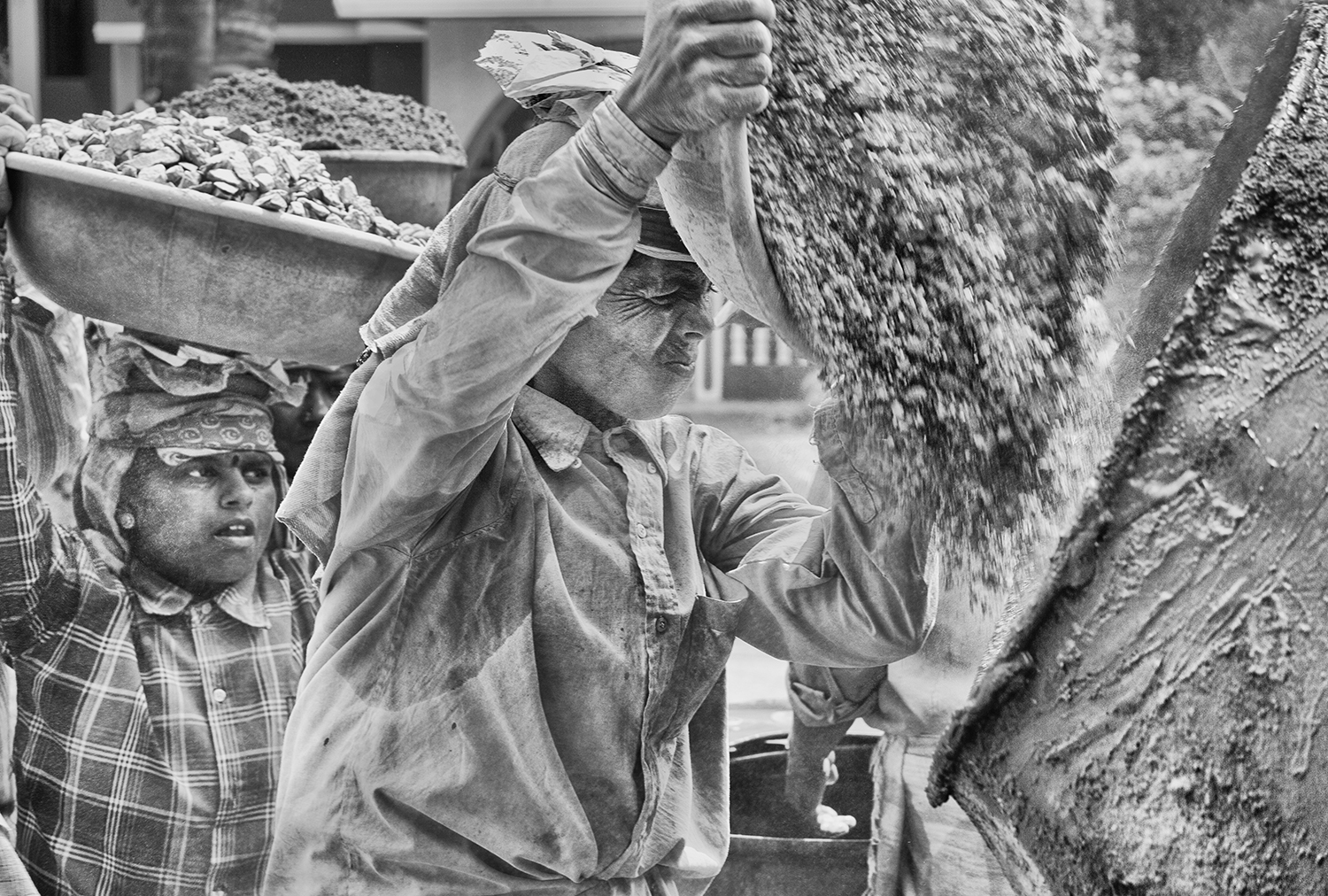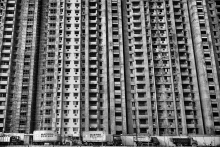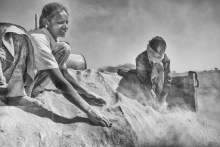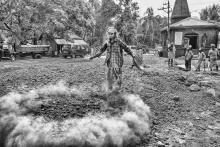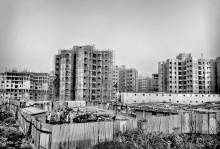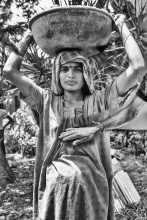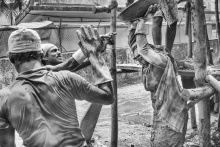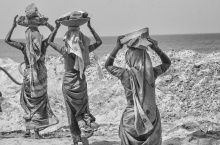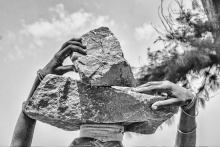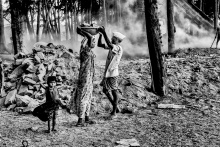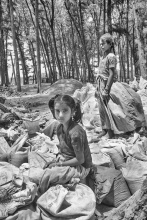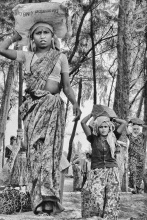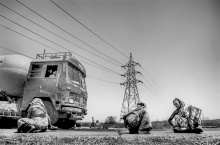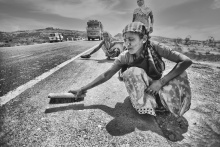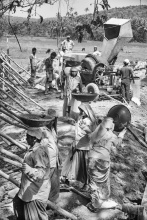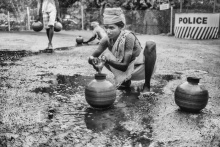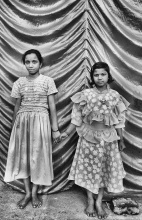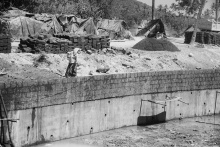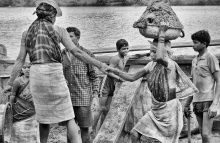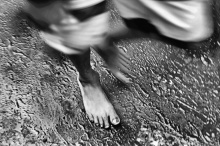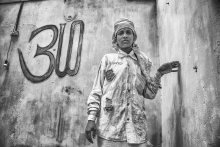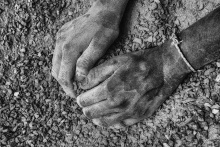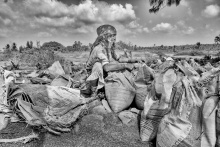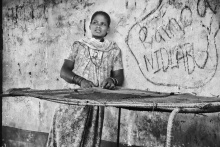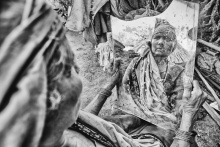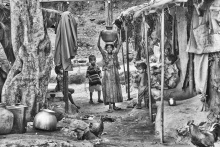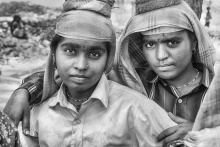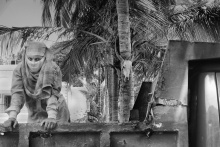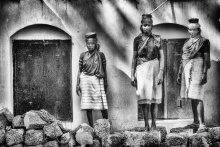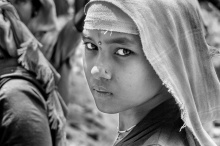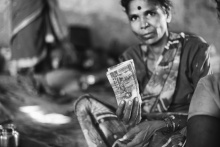2013-2015 INDIA - BREATHING DUST - DEE DELLA POLVERE
ita
Donne e lavoro edile in India
BREATHING DUST - DEE DELLA POLVERE
L’India del progresso è un "cantiere a cielo aperto”. Nelle grandi città e nei centri turistici si costruiscono infrastrutture, nuovi palazzi, uffici, alberghi, ponti, autostrade e la polvere, che s'insinua ovunque in modo ostinato, è la trama sottile ed invisibile che unisce le vite ed i destini di molte donne indiane che lavorano nel settore edilizio.
In un recente rapporto sul lavoro femminile è risultato che la maggioranza (più del 40%) lavora nel settore agricolo, ma negli ultimi anni si è notato che il numero di donne impiegate nel settore edile è aumentato in modo esponenziale.
Data l’abbondanza di lavoro, interi gruppi familiari, tendenzialmente appartenenti a caste basse e senza educazione, si spostano dalle zone rurali verso le città e tutti: uomini, donne, anziani e bambine, che spesso iniziano a lavorare già all’età di 10-12 anni (malgrado una legge nazionale che vieta il lavoro ai minorenni in età scolastica (16 anni) sono impegnati per mesi e mesi in un lavoro estenuante con orari e temperature infernali.
La metà della forza lavoro nei cantieri è costituita da donne di ogni età, ad esse è riservato il duro lavoro di trasportare, sulle loro teste, pietre, mattoni, sabbia, cemento, legni e bambù per le impalcature, tutto il giorno e giorno dopo giorno per mesi senza nessuna possibilità di riqualificazione sul lavoro. Vivono in condizioni estreme, negli stessi cantieri, ricavandosi un minimo di riparo con plastiche, lamiere, teli e cartoni, spesso senza servizi o uso di acqua che viene riservata per ‘curare’ il cemento.
Le operaie edili non hanno nessuna forma di assicurazione malattie e protezione personale rimanendo continuamente esposte a rischi di intossicazione da polveri di cemento, gesso e calce, a fumi tossici e a malattie come la silicosi data dalla sabbia e ai diversi tipi di cancro alle vie respiratorie e alla pelle.
Spesso, anche quando sono in attesa di figli, lavorano fino all’ultimo giorno e tornano al lavoro dopo 14 giorni per non perdere il salario. Allattano di nascosto e in fretta, Iasciando i neonati alle cure dei tanti bambini che popolano i cantieri perché ancora troppo piccoli per lavorare.
Sono spesso esposte a violenze verbali e sessuali da parte dei lavoratori e capi mastri a cui sottostanno in silenzio pur di guadagnarsi la giornata. Sovente sono vittime di infortuni e malattie in un settore con un altissimo tasso di incidenti sul lavoro.
La discriminazione salariale é un’altro dei grandi problemi che devono subire. Anche qui una recente legge nazionala equipara i salari fra uomini e donne e, pur ricoprendo le funzioni di operaia, madre e moglie, ricevono una diaria inferiore a quella degli uomini, sebbene siano proprio loro il cuore e l'anima pulsante di questo Paese.
Pur ricoperte di polvere affrontano le giornate e il lavoro con resilienza, sanno di essere le “ultime” nella scala sociale dei lavori, ma sono consapevoli che senza la loro ‘polvere’ nessun cantiere può sopravvivere!
Testo - Monica Rostagno
eng
Women and work at construction sites in India
The progressive and modern India looks like ‘an open-air workshop’. In big cities and touristic centers they build infrastructure, new buildings, offices, hotels, bridges, highways and the dust, that creeps everywhere so stubbornly, is the subtle and invisible thread uniting the lives and destinies of many Indian women working in the construction industry.
In a recent report on women's work it turned out that the majority (over 40%) work in agriculture, but in recent years it is noted that the number of women employed in the construction industry increased exponentially. Given the abundance of work, family groups, which often belong to backward caste, schedule caste or minority groups, are moving from rural areas to the cities and all: men, women, elderly, and children, who often begin to work at the age of 10-12 years (despite a national law that prohibits work by minors in school age (16 years)) have been engaged for months in grueling schedules and hellish temperatures.
Half of the labor force at construction sites is made up of women of all ages; to them is reserved the hardest work of carrying on their heads stones, bricks, sand, cement, and wood, or bamboo used in scaffolding, all day and every day for months, without any chance of re-qualification at work. They live in extreme conditions, at the construction site, conquering the minimum shelter with plastic sheets, tarpaulins and cardboard, often without services or use of water, that is reserved to ' cure ' the cement
Construction workers do not have any form of health insurance or personal protection, remaining continuously exposed to the risk of poisoning from cement, plaster and lime powders, toxic fumes and diseases such as silicosis caused by sand and to different types of cancer of the respiratory system and skin.
Often, even when they are pregnant, they work until the last day and return to work after 14 days so as not to lose the salary ... Nursing mothers do it secretly and quickly, leaving the infants in the care of the many children that populate the sites because they’re still too small to be employed on the site. They are often exposed to verbal and sexual violence by workers and master builders, and they keep silent in order to survive the day. Often they are victims of accidents and diseases in an industry with a high rate of workplace accidents. Wage discrimination is another of the major problems that women must suffer. A recent law equates national wages between men and women and, while covering the functions of worker, mother and wife, they receive a daily allowance which is less than that of men, although they are the pulsating heart and soul of this country.
Covered in dust they face the days and the work with resilience, they know they are the last workers in the social ladder, but are also aware that without their ' dust ' no construction site can survive!
Text:Monica Rostagno
Copyright Shobha
All rights reserved
Donne e lavoro edile in India
BREATHING DUST - DEE DELLA POLVERE
L’India del progresso è un "cantiere a cielo aperto”. Nelle grandi città e nei centri turistici si costruiscono infrastrutture, nuovi palazzi, uffici, alberghi, ponti, autostrade e la polvere, che s'insinua ovunque in modo ostinato, è la trama sottile ed invisibile che unisce le vite ed i destini di molte donne indiane che lavorano nel settore edilizio.
In un recente rapporto sul lavoro femminile è risultato che la maggioranza (più del 40%) lavora nel settore agricolo, ma negli ultimi anni si è notato che il numero di donne impiegate nel settore edile è aumentato in modo esponenziale.
Data l’abbondanza di lavoro, interi gruppi familiari, tendenzialmente appartenenti a caste basse e senza educazione, si spostano dalle zone rurali verso le città e tutti: uomini, donne, anziani e bambine, che spesso iniziano a lavorare già all’età di 10-12 anni (malgrado una legge nazionale che vieta il lavoro ai minorenni in età scolastica (16 anni) sono impegnati per mesi e mesi in un lavoro estenuante con orari e temperature infernali.
La metà della forza lavoro nei cantieri è costituita da donne di ogni età, ad esse è riservato il duro lavoro di trasportare, sulle loro teste, pietre, mattoni, sabbia, cemento, legni e bambù per le impalcature, tutto il giorno e giorno dopo giorno per mesi senza nessuna possibilità di riqualificazione sul lavoro. Vivono in condizioni estreme, negli stessi cantieri, ricavandosi un minimo di riparo con plastiche, lamiere, teli e cartoni, spesso senza servizi o uso di acqua che viene riservata per ‘curare’ il cemento.
Le operaie edili non hanno nessuna forma di assicurazione malattie e protezione personale rimanendo continuamente esposte a rischi di intossicazione da polveri di cemento, gesso e calce, a fumi tossici e a malattie come la silicosi data dalla sabbia e ai diversi tipi di cancro alle vie respiratorie e alla pelle.
Spesso, anche quando sono in attesa di figli, lavorano fino all’ultimo giorno e tornano al lavoro dopo 14 giorni per non perdere il salario. Allattano di nascosto e in fretta, Iasciando i neonati alle cure dei tanti bambini che popolano i cantieri perché ancora troppo piccoli per lavorare.
Sono spesso esposte a violenze verbali e sessuali da parte dei lavoratori e capi mastri a cui sottostanno in silenzio pur di guadagnarsi la giornata. Sovente sono vittime di infortuni e malattie in un settore con un altissimo tasso di incidenti sul lavoro.
La discriminazione salariale é un’altro dei grandi problemi che devono subire. Anche qui una recente legge nazionala equipara i salari fra uomini e donne e, pur ricoprendo le funzioni di operaia, madre e moglie, ricevono una diaria inferiore a quella degli uomini, sebbene siano proprio loro il cuore e l'anima pulsante di questo Paese.
Pur ricoperte di polvere affrontano le giornate e il lavoro con resilienza, sanno di essere le “ultime” nella scala sociale dei lavori, ma sono consapevoli che senza la loro ‘polvere’ nessun cantiere può sopravvivere!
Testo - Monica Rostagno
eng
Women and work at construction sites in India
The progressive and modern India looks like ‘an open-air workshop’. In big cities and touristic centers they build infrastructure, new buildings, offices, hotels, bridges, highways and the dust, that creeps everywhere so stubbornly, is the subtle and invisible thread uniting the lives and destinies of many Indian women working in the construction industry.
In a recent report on women's work it turned out that the majority (over 40%) work in agriculture, but in recent years it is noted that the number of women employed in the construction industry increased exponentially. Given the abundance of work, family groups, which often belong to backward caste, schedule caste or minority groups, are moving from rural areas to the cities and all: men, women, elderly, and children, who often begin to work at the age of 10-12 years (despite a national law that prohibits work by minors in school age (16 years)) have been engaged for months in grueling schedules and hellish temperatures.
Half of the labor force at construction sites is made up of women of all ages; to them is reserved the hardest work of carrying on their heads stones, bricks, sand, cement, and wood, or bamboo used in scaffolding, all day and every day for months, without any chance of re-qualification at work. They live in extreme conditions, at the construction site, conquering the minimum shelter with plastic sheets, tarpaulins and cardboard, often without services or use of water, that is reserved to ' cure ' the cement
Construction workers do not have any form of health insurance or personal protection, remaining continuously exposed to the risk of poisoning from cement, plaster and lime powders, toxic fumes and diseases such as silicosis caused by sand and to different types of cancer of the respiratory system and skin.
Often, even when they are pregnant, they work until the last day and return to work after 14 days so as not to lose the salary ... Nursing mothers do it secretly and quickly, leaving the infants in the care of the many children that populate the sites because they’re still too small to be employed on the site. They are often exposed to verbal and sexual violence by workers and master builders, and they keep silent in order to survive the day. Often they are victims of accidents and diseases in an industry with a high rate of workplace accidents. Wage discrimination is another of the major problems that women must suffer. A recent law equates national wages between men and women and, while covering the functions of worker, mother and wife, they receive a daily allowance which is less than that of men, although they are the pulsating heart and soul of this country.
Covered in dust they face the days and the work with resilience, they know they are the last workers in the social ladder, but are also aware that without their ' dust ' no construction site can survive!
Text:Monica Rostagno
Copyright Shobha
All rights reserved

